Fig 1
From "Broadsword and Singlestick - with Chapters on Quarter-staff, Bayonet, Cudgel, Shillalah, Walking Stick, Umbrella and other Weapons of Self Defence.", Allanson-Winn, R.G. and C. Phillipps-Wolley, London : George Bell & Sons. 1st edition, 1898.
ACCORDING to Chambers's "Encyclopaedia," the quarter-staff was "formerly a favourite weapon with the English for hand-to-hand encounters." It was "a stout pole of heavy wood, about six and a half feet long, shod with iron at both ends. It was grasped in the middle by one hand, and the attack was made by giving it a rapid circular motion, which brought the loaded ends on the opponent at unexpected points."
"Circular motion" and "shod with iron" give a nasty ring to this description, and one pictures to one's self half a barge-pole, twirled - "more Hibernico" - with giant fingers, bearing down on one.
Whether the fingers of our ancestors were ever strong enough to effect this single-handed twirling or not must remain a matter of doubt, but we may rest assured that in the quarter-staff we have, probably, the earliest form of defensive weapon next to a handy stone. If Darwin is right, we can easily imagine our gorilla ancestors picking up a big branch of a tree with which to hit some nearby member of his family. This, to my mind, would be playing elementary quarter-staff, and the game would be advanced a step if the assaulted one - possibly the lady gorilla - had seized another branch and retaliated forthwith.
The modern quarter-staff is supposed to be rather longer than the six and a half feet prescribed by the above-quoted authority , and I imagine it originally derived its name from being grasped by one hand at a quarter of its length from the middle, and with the other hand at the middle.
Thus, in the diagram (Fig. 1), if A E represents a quarter-staff eight feet long, divided into four equal two-foot lengths at the points B, C and D, the idea would be to grasp it with the right hand at D and with the left hand at C; or, if the player happened to be left handed, to grasp it with the left hand at B and the right hand at C.
This method of holding the quarter-staff may be well enough in certain cases, but it seems to me that, for rapid attack and defence, the hands should be about three feet apart; at D and M, half way between B and C; or at B and N, half way between C and D.
Of course a great deal depends upon the height and strength of the player, but, with the hands at a distance of three feet or so apart, it stands to reason that you have a greater control over the ends of the staff than you have if they are only two feet apart, and that you can consequently come quicker into "hanging guard" positions, and more easily defend yourself from short upper strokes and from "points" than you can when you have less control over your weapon.
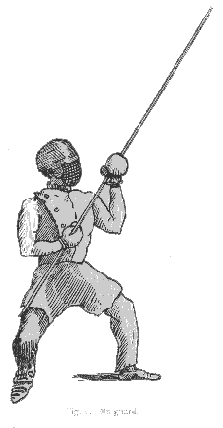
Before proceeding to the more technical portions of quarter-staff play, let me say that it is better to bar "points" in a friendly bout, for the weight of a stick, if only a bamboo cane, of eight feet long, is so great, that it is an easy matter to break a collar-bone or rib with a rapid thrust. In any case, remember to be well-padded and to have a good iron-wire broadsword mask on before engaging in a bout.
| In dealing with the cuts and thrusts which may be made with the quarter-staff, we cannot do better than consider the ordinary broadsword target. In the accompanying diagram are marked the ordinary broadsword cuts 1 to 4, 2 to 3, 3 to 2, 4 to 1, 5 to 6, 6 to 5 and 7 to 0, the centre of the target. |
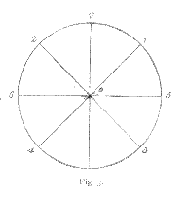 Fig 3 |
Now, we observe that the guards for these cuts must be such as to ward off the blows in the easiest manner and with as rapid return as possible to the attacking position. (EN1)
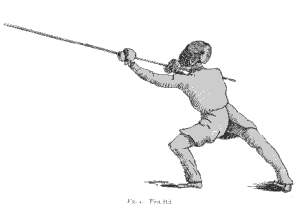
With the quarter-staff in the hands of a right-handed man, the first cut would be from 2 to 3, and the guard for this would be with the staff held in the direction of c to d. Similarly, for cut two, from 1 to 4, the guard would be from a to b.
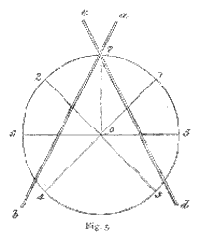
It must be borne in mind that this second cut, from 1 to 4, is generally delivered with what I shall call the butt of the staff, i.e. with that end which is nearest the right hand, in the case of a right-handed man; and that cut 1, from 2 to 3, would be delivered with the butt in the case of a left-handed man. [see fig 9]
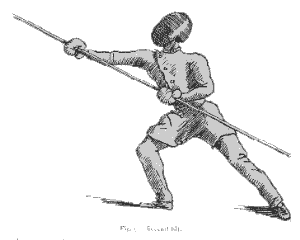

The two guards [Fig 6 and 7] above illustrated will cover almost any attack, but not quite.
On examining figure 8, it will be seen that the guard for the first cut, vis. that from 2 to 3 on the target, is indicated by the position of the staff cd or c1d1. The guard cd meets the three cuts 6 to 5, 2 to 3 and 7 to 0, but is not sufficient to protect you against cut 4 to 1.

Similarly the guard c1d1 answers the purpose as far as cuts 4 to 1, 6 to 5 and 2 to 3 are concerned, but fails to ward off cut 7 to 0; and the same remarks apply to the other side of the target, where ab and a1b1 represent the staff.
Of course the two guards in Fig 5. may be so used as to meet all requirements, but it is, to my thinking, far preferable to thoroughly master the four represented in Fig. 8. So doing will give increased command over the staff, and will not detract in any way from speed or general efficiency.
It will be observed that in the sketches of guard 1 and guard 2, Figs. 6 and 7, the staff is, in each case, too perpendicular for cut 7 to 0; they represent the positions of the combatants when using guards a1b1 and c1d1 in Fig. 8.
I would therefore advise attention to the diagram, which includes the guards, four in number, which are really sufficient for all hits which can be made with the quarter-staff.
The lines intersecting the circumference of the circle show the inclinations of the staff for guarding all the cuts that can be made.
We now turn to the question of position. In quarter-staff play it is usual for a right-handed man to stand with his left foot in advance of the right, as in boxing or bayonet exercise, and with his toe pointing straight in the direction of his adversary, as in Fig. 2. It is, however, often very advisable to advance the right foot suddenly to the front when bringing the butt of the staff to play on the left side of the enemy's head or body. As regards "points" it is well to lunge out, as one does when making a left-handed lead-off in boxing, so as to gain somewhat in reach.

Points, which, as before hinted, should be used with care in friendly bouts, are generally made with the point of the staff, but may also be effected with the butt end; and this is the case when the combatants have come to rather close quarters.
At quarter-staff play the men should be started by the Master of Ceremonies at a distance of ten or twelve feet apart, and when they get to close quarters, or at rough play, they should be immediately separated, as this is a game at which feeling is apt to run somewhat high occasionally.
Always remember, when guarding points, to do so with that portion of the staff which lies between your hands. This portion really corresponds with the "forte" of a sword or stick. If you have learned fencing with the foils it will be of the greatest possible advantage to you, for you will then understand how slight an effort brought to bear on the foible of your opponent's staff - in this case it will be somewhere within two feet of the end - will suffice to turn aside the most vigorous thrusts.
It may not be out of place to add that any man who has gone through any sort of apprenticeship in fencing - either with foils or single-sticks - will not fail, when a quarter-staff is put into his hands, to know what to do with his weapon. He may, at first, feel awkward, and the length of the staff may hamper him and its weight fatigue him, but he will, with his knowledge of general principles, very soon get into the work and enjoy it.
Though the staves are often made of light bamboo cane, one may get very sever hits and prods, so it is as well, before engaging in an encounter, to have (a) a good mask, such as broad-swordsmen wear; (b) a thick jacket of stout leather, with a high collar; (c) boxing-gloves on both hands; (d) a good pad for the middle of the body, from waist to knee; and (e) cricket pads, which are apt to come in for nasty jars, at or about the knee. Never on any account try to dispose with the pads - they may save you from permanent injury; and do they not add to your good health by promoting a beneficial opening of the sweat-glands?
In quarter-staff, as in stick-play, broad-sword exercise, fencing, etc., it is better to sink down with the knees bent, for in this position you present a smaller area for your opponent to strike at than you do when quite erect.
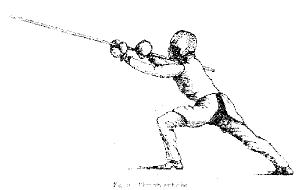
In leading off it is better to slide the hand which is at M or N (see Fig. 11) down to the hand which is at D or B; you then gain several feet of reach added to your lunge out; only be careful to recover quickly, and get the hand you have thus moved back to its former position.
Advancing and retreating are effected much in the same way as in bayonet exercise; viz. for the advance, move your left foot swiftly forward in the direction of your opponent for a distance of, say, eighteen inches or two feet, following this up with the right foot for the same distance, so that the same relative positions are maintained; for the retreat, move the right foot back the required distance and follow up with the left foot.
In speaking of the retreat, it must be mentioned that, from the great length of the staff, you cannot, very often, get out of the way by the ordinary retreat, as above described, but may have to make an undignified jump back for five or six feet, to avoid a quick return or, possibly, an unexpected lead-off. In a stiff bout this jumping, with all the heavy impedimenta indispensable to the game, takes it out of one considerably, and on this account, it is a first-rate exercise for any man who may wish to get into good training.
The most common mistake learners of quarter-staff make is that they try very long sweeping hits, which are easily guarded, instead of shorter and sharper taps, which run up points and are much more scientific.
Your sweeping hit may be likened to the "hook-hit" at boxing, for it lays open your weak points and leaves you for an instant in a position from which there is a difficulty in recovery.
In all these games be well "pulled together." Watch a good fencer, either with the foils or with the sticks; see how seldom his point wanders far from the lines of attack, and how quick he is with the returns. You cannot guard and return with any sort of effect if you go in for ugly sweeping hits or hard heavy guards.
The heavy hit may come off occasionally, the clumsy guard may turn the point, but why misdirect energy? It is surely unnecessary to put forth great muscular effort when you know that the strength of a small child, if properly applied, is ample to put aside the most powerful thrust or the heaviest cut.
If quite unacquainted with fencing, broad-sword, stick-play, or bayonet-exercise, never be tempted into a bout with the quarter-staff. No one should ever go in for this game without previous knowledge.
My own idea is that learning fencing with the foils should precede all the above-named exercises, for in this way a delicacy of touch and nicety in the matter of guarding are acquired, which may lay a really good foundation.
Nearly all first-rate stick-players have served their apprenticeship with the foils, and, where this education has been omitted, one may generally detect the ugly carving-knife-and-fork style, so unpleasant to watch. Whereas with a good fencer - "foiler" perhaps I should say - everything is done with neatness, whether he has in his hand a single-stick, a cutlass, or the leg of an old chair.
So that it comes to this: We seek the aid of the newest and most delicate weapon of attack and defence - the small-sword - to teach us how to properly make use of the most ancient and clumsy of weapons - the time-honoured quarter-staff!
(EN1) - Figures 5 and 8 represent the attacker's perspective as if standing in front of the diagram, and the defender's perspective as if standing behind the diagram.